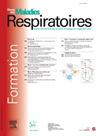Kcnk3 deficiency aggravates right ventricular dysfunction induced by pulmonary artery banding
IF 0.5
4区 医学
Q4 RESPIRATORY SYSTEM
引用次数: 0
Abstract
Introduction
Right ventricular failure (RVF) is characterized by the inability of the right ventricle (RV) to maintain adequate blood flow and is the major predictor of mortality in pulmonary arterial hypertension (PAH). PAH is defined by a mean pulmonary arterial pressure greater than 20 mmHg at rest and is characterized by increased pulmonary vascular resistance, leading to right heart failure. Currently, no treatments specifically target RVF in PAH. However, slowing down the progression of RVF could delay the need for double lung transplantation and reduce PAH-related mortality. Loss-of-function mutations in the KCNK3 (Potassium channel subfamily K+ member 3) gene, which encodes the potassium channel known as TASK-1 (TWIK-related acid-sensitive K+ channel 1), have been identified in PAH patients. Our team has recently shown that KCNK3 dysfunction is involved in pulmonary vascular remodeling and contributes to the development of PAH [1]. They also demonstrated that reduced function and expression of KCNK3 is a hallmark of RV hypertrophy and dysfunction associated with pulmonary hypertension [2].
Our objective was to investigate whether the Kcnk3 deficiency exacerbates RV remodeling in a rat model of RV dysfunction induced independently of pulmonary vascular remodeling.
Methods
To address this, we subjected male and female Kcnk3-deficient rats (WT, heterozygous, and homozygous) to chronic RV pressure overload by pulmonary artery banding (PAB). 4 weeks after surgery, we analyzed the consequence of Kcnk3-deficiency on RV remodeling by performing echocardiography, right heart catheterization, and RV histology.
Results
Our results show that rats (males and females) subjected to PAB developed RV hypertrophy and RV dysfunction. In male homozygous Kcnk3-deficient rats, PAB led to an exacerbation of RV hypertrophy, RV dilatation, and a more pronounced increase in RV systolic pressure compared to WT-PAB rats. In contrast, no difference was observed in male heterozygous Kcnk3-deficient rats compared to WT-PAB male rats. Interestingly, RV dysfunction and hypertrophy were unchanged in female homozygous Kcnk3-deficient rats subjected to PAB compared to WT-PAB female rats.
Conclusion
In conclusion, our results suggest that KCNK3 dysfunction is a crucial event in the physiopathology of RV failure. Further studies are needed to understand underlying molecular and cellular mechanisms and to investigate sex differences linked to Kcnk3-deficiency in these experimental conditions.
求助全文
约1分钟内获得全文
求助全文
来源期刊

Revue des maladies respiratoires
医学-呼吸系统
CiteScore
1.10
自引率
16.70%
发文量
168
审稿时长
4-8 weeks
期刊介绍:
La Revue des Maladies Respiratoires est l''organe officiel d''expression scientifique de la Société de Pneumologie de Langue Française (SPLF). Il s''agit d''un média professionnel francophone, à vocation internationale et accessible ici.
La Revue des Maladies Respiratoires est un outil de formation professionnelle post-universitaire pour l''ensemble de la communauté pneumologique francophone. Elle publie sur son site différentes variétés d''articles scientifiques concernant la Pneumologie :
- Editoriaux,
- Articles originaux,
- Revues générales,
- Articles de synthèses,
- Recommandations d''experts et textes de consensus,
- Séries thématiques,
- Cas cliniques,
- Articles « images et diagnostics »,
- Fiches techniques,
- Lettres à la rédaction.
 求助内容:
求助内容: 应助结果提醒方式:
应助结果提醒方式:


